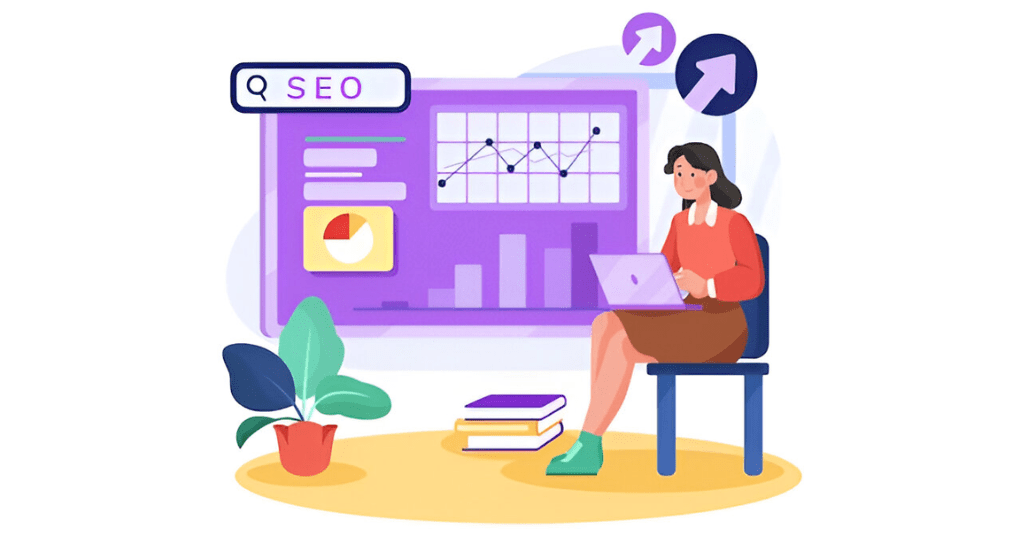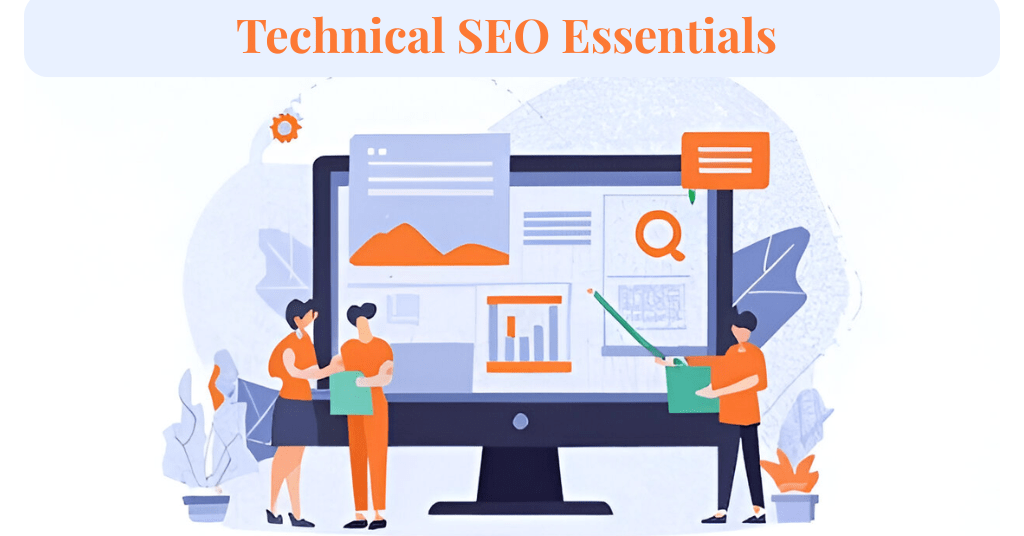How to Optimize Your New Site for Google SEO Success – Building a new website is only the start of your web existence. The true test comes when you need to direct visitors to your site without incurring much expenditure on advertising. That is where Google SEO comes into the picture. SEO refers to Search Engine Optimization, i.e., optimizing your site so that it is listed higher up in search engine results when users look for pertinent information on Google. A new website typically has no traffic and no search engine listing, but if you follow the right SEO practices, you can get found, receive organic traffic, and build trust in the long term. This manual will walk you step by step through how to optimize your new website for Google SEO success from Keyword research through Technical SEO and Content strategy. Whether you are starting a Blog, Business site, or Online store, these tactics will set you on the right path.
How to Optimize Your New Site for Google SEO Success
Understanding the Basics of Google SEO –
Google SEO is all about telling Google what your website is about and ensuring that it is helpful, trustworthy, and relevant to users. Google employs automated computer programs called “bots” to crawl your website and index your content. It then employs sophisticated algorithms to determine how your website should rank in search results.

Google SEO
Google considers a lot of things when ranking your site, including the relevance of your content to the user’s search, the quality and quantity of links pointing to your site, the speed of your site to load, whether it is mobile-friendly or not, and whether it gives a good user experience or not. By being mindful of and adhering to these guidelines, you help Google better understand, trust, and recommend your site. Keep in mind that Google wants to give its audience the best possible answers, and the more useful your content and structure are, the better you will rank.
Keyword Research for a New Website –
Keyword research is where SEO is successful. It is the issue of the discovery of what everyone is looking for under your topic and then writing contents to be directed towards that keyword. When your site is new, you will have to focus on long-tail keywords those are longer and more descriptive words like “How to start a fitness blog for beginners” instead of “Fitness blog.” Long-tail keywords are easier to rank because there is not much competition. You can utilize free tools like Google Keyword Planner, Ubersuggest, or AnswerThePublic to find keyword suggestions.

Keyword Research for a New Website
Discover high volume, low competition keywords. Then, organize your keywords by topic so that you can create focused pages or blog posts based on each one of them. Do not just plop keywords down randomly throughout all your copy. Instead, put them where they occur naturally in your Titles, Paragraphs, Meta tags, and URLs. This is in the interest of both users and Google since it makes the main topic of every page on your website obvious.
Optimizing On-Page SEO –
On-page SEO refers to the stuff you can get done on each page on your site so that it will rank higher in Google. If you are adding a new page, make the title contain the main keyword and let users easily know what purpose the page will serve. Place the keyword and optimize your meta description to elicit clicks among search engine visitors. Keep the page URL short, readable, and including the keyword wherever feasible.

Optimizing On-Page SEO
Make your content readable in a proper format using headings (e.g., H1 as title and H2 or H3 as sub-heading). Apply images having good alt text that talks about what the image is describing using keywords wherever feasible. Internal linking between your other similar pages on your website notifies Google about the relationship between your content items. These small adjustments in total make your website more useful to users and more understandable to Google to rank properly.
Mobile Optimization and Site Speed –
More people browse the web on mobile devices than on computers nowadays, so make sure your site is mobile-friendly. Google does mobile-first indexing, and that means it indexes the mobile version of your site first before ranking your site. You will lose traffic and rankings if your site is not responsive, takes forever to load, or is hard to use on mobile devices. To be mobile-friendly, add a responsive design that will automatically scale and fit different screen sizes. Avoid too many pop-ups covering content and make buttons and links easily accessible to tap.

Mobile Optimization and Site Speed
Site speed is also a highly crucial ranking factor. A slow site leads to higher bounce rates and rankings. You can also optimize speed through image compression, Hosting on a quick host, minimizing dependence on big plugins, browser caching, and utilizing a CDN (Content Delivery Network). Use tools like Google Page Speed Insights to scan your website and make the suggested changes to have your website fast and responsive.
Technical SEO Essentials –
Technical SEO ensures that the behind the scenes setup of your website is done in a way that search engines are able to crawl, index, and rank your content correctly. To begin with, your website must be HTTPS enabled, i.e., secure, and trustworthy to users and Google as well. Second, have a straightforward site structure with clear navigation, in a way that visitors and spiders can find main pages easily. Insert an XML sitemap into Google Search Console to enable Google to find all your pages. Create a robots.txt file to instruct search engine spiders where they can or cannot crawl. Remove broken links and repair crawl errors that might be reported by Google Search Console.

Technical SEO
Ensure your site is duplicate content issue free, and each page has canonical tags utilized wherever necessary. A technically clean site gives your content its best chance for success in search because it offers a clean and problem free environment for both search engines and end users.
Creating High-Quality Content –
Content is the base of your SEO campaign. Without useful and original content, optimization will not make your site get ranked. Google prefers pages that contain useful, informative, organized content. In creating content, keep in mind solving real problems for your audience. Break it down to them in simple language, offer practical examples, and break information into bite sized bits. Use your key words organically and toss in related key words to put things into perspective. Content well written is also convincing place images, infographics, video, and facts to your work to get the message out. Follow Google’s E-E-A-T principles that are Experience, Expertise, Authoritativeness, and Trustworthiness.

High-Quality Content
These characteristics breathe life to your content as being authoritative and rank worthy. Revamp outdated content on a continuous basis as part of trying to make it current and up to date. In the long run, good content regularly established gets credibility for your website and has other websites link to you, which also increases your rankings.
Building Backlinks and Authority –
Backlinks are links on other sites that lead to your site, and they are an excellent way of telling Google your site is authoritative. If someone decent links to your site, it is the equivalent of casting a vote. Not all backlinks are created equal, though links on high-authority and relevant sites are worth more than links from low-authority or irrelevant sites. To create backlinks, start with content which others will like to link on such as helpful guides, pioneering studies, or utilities to download. Visit sites within your niche and pitch guest articles or ask them to link back to your website for reference purposes.

Backlinks and Authority
List businesses within directories and get involved with web forums where one can exchange ideas and link to one’s own website naturally. Avoid underhanded tactics like buying links or linking in link farms, since these will get you a Google penalty. Constant quality backlink building makes you stronger and allows your new website to rank faster.
Leveraging Google Tools for SEO –
Google also offers some free tools which can easily change your SEO experience. Google Search Console allows you to submit your Sitemap, check indexing status, and search for technical problems which might drive you mad when it comes to ranking. Google Search Console tells you how precisely keywords people use when searching for your webpage too. Google Analytics also gives you useful information on what’s your users’ activity on your website like where they are heading, how long they remain there, and from where they came. So, you know what is, and is not working. Google Page Speed Insights allows you to test your site speed and will notify you with precise instructions about how you can make your site speed faster. If you are an established local business, then Google Business Profile enables your site to be featured on local search pages and Google Maps. These are the tools which you must utilize for informed decision-making, monitoring progress, and enhancing your SEO performance over the long run on a regular basis.
Monitoring, Updating, and Improving SEO Over Time –
SEO is never something that you do once but something that you continually do. You have built your website and web-optimized your website, now you need to track your performance daily to beat others. Track keyword rankings, your source of traffic, and user behavior with Google Search Console and Analytics. Track which pages are working well and others lag. Replace Old content with fresh content, new images, and improved design. New content informs Google that your website is active and real.
Additionally, monitor the changes in Google algorithms and adapt your strategy accordingly. Try to perform a full SEO audit every few months to find and correct new problems. Monitor the competition and see what they are doing as well. As days go by, this commitment towards ongoing development will cause your site to move forward in the ranks and increasingly become ubiquitous.
Common SEO Mistakes to Avoid –
Even with the best of intentions, most new website owners make some of the same SEO errors that damage their rankings. One of the most egregious errors you can make is keyword stuffing, where you repeat the same keyword over and over and make the content unnatural. Another error is duplicating content on several pages, which confuses Google and can lower your rankings. Most individuals over look mobile optimization, which is a key ranking signal. Others do not use analytics tools, so they do not know what is working and where they are losing traffic. Technical issues such as broken links, Slow pages, and not using HTTPS also hurt SEO.

SEO Mistakes to Avoid
Finally, solely relying on paid traffic or social media without optimizing SEO means you miss long-term organic growth. Steering clear of them right from the start means you set up a good SEO base and you do not have problems later.
Conclusion –
Optimizing your new site Google SEO is one of the most significant things you can do to expand online. It will be work, but the long-term benefits of sustained, natural traffic are well worth it. Begin by understanding how Google SEO functions, do good keyword research, and write quality, informative copy. Have your site quick, responsive, and well-technical. Create backlinks from trusted sites and utilize the free resources that Google provides to monitor your progress. More than anything else, test SEO as a method that needs to be updated and followed throughout time. Through these steps, not just will your site be above search rankings but also be one that people will trust and return to repeatedly.
Read Also Another Article –
10 Proven SEO Techniques You Need to Know
Frequently Asked Questions –
Q. 1. What is Google SEO and Why is it Important?
Ans – Google SEO, also known as Google Search Engine Optimization, is optimizing your site to rank more highly in the natural (i.e., non-paid) results of Google searches. It involves optimizing your Content, Site organization, Keywords, Mobile friendliness, Page load speed, and Backlink scheme to make your website more worthy and useful for users for searching for something. Since Google is the world’s most popular search engine, Google SEO is vital if you would like to reach millions of online shoppers, drive traffic, and boost your visibility. When your website ranks higher on Google, more individuals can view it, and this may lead to heightened Brand awareness, leads, and Sales. Without SEO, even best designed websites can be invisible to users and search engines. It is especially significant to small and new companies who would like to depend on natural search to reach consumers without necessarily paying humongous sums of money for advertisements. Google SEO also builds long-term credibility and trust on your site as users are likely to feel that highly ranked pages are more authoritative and trustworthy.
Q. 2. How does Google SEO Work for Websites?
Ans – Google SEO is gained from a combination of On-page, Off-page, and technical factors that signal to Google algorithms the value and usefulness of your website. Google uses computer software known as crawlers that creep and index content on your webpage. Depending on over 200 ranking signals, Google then determines how to rank your website for a variety of search queries. These ranking signals include Keyword use, Page loading speed, Mobile-friendliness, Backlinks, Site architecture, and user interactions such as bounce rate and pages per session. Google ranks millions of pages when a user conducts a search query and shows the most helpful, relevant, and authoritative content. Other than that, to ensure your website is helped by SEO, you need to optimize your content periodically with keyword phrases, make your site well-organized and easy to read, fix technical issues like page loading issues or broken links, and acquire high-quality backlinks from other relative and authoritative sites. SEO is an ongoing process that requires ongoing maintenance and optimization to maintain or improve rankings because Google’s algorithms are constantly changing.
Q. 3. What are the best Practices for Google SEO?
Ans – Google SEO best practices put good quality content creation, user experience, and adherence to Google’s quality guidelines first. Of course, the most significant application of naturally integrated keywords about your subject in your content tells Google what your site is about. Creating informative, readable, and engaging content that answers your users’ questions keeps people longer on your site, thereby enhancing ranking. Optimizing your title tags, meta descriptions, headings, and alt image text enhances your content’s reach and readability to users and Google. Being mobile friendly and taking just one second to load is also necessary since user experience means everything to Google. Establishing high-authority backlinks from high-authority domains signals that your site is authoritative. Having fresh material on a consistent basis, fixing dead links, and having an HTTPS secure connection also helps in SEO success. Helping to gauge performance and identifying areas for optimization is with the help of tools like Google Search Console and Google Analytics. Updating these best practices on a regular basis ensures your site not just ranks higher, but also provides an excellent visitor experience, leading to better engagement and conversion.
Q. 4. Why Should You Invest in Google SEO?
Ans – Google SEO investment offers businesses and website owners long-term value and high ROI. Unlike the payment for advertisement which ceases to generate traffic once it is expired, SEO continues to generate organic traffic in the long run without recurring ad payments. By advertising your Google visibility, SEO attracts users who are actively searching for products, services, or information about your business. This pushes in higher quality traffic with a greater potential to be converted. SEO also enhances the trust and the authority of a brand because human beings trust higher pages in Google’s search. SEO also enhances the experience of users because the websites become quicker, better structured, and there is better content, thus enhancing the user interaction as well as the rate of user satisfaction.
For businesses, especially for small businesses, the investment in SEO is in expensive as a benchmark of competing with behemoth players. It helps in building an online presence, reaching new audiences, and adapting to changing consumer behavior in a digital first economy. SEO is typically a long-term and strategic investment that fuels growth, credibility, and online success.
Q. 5. How Can I Measure My Google SEO Performance?
Ans – Monitoring your Google SEO performance involves observing important metrics showing how well ranked your website appears on search and what your visitors are doing with your content. One of the most valuable devices to accomplish that is Google Search Console, and it provides insight into your search impressions, click-through rates, keyword positions, indexing issues, and mobile usability. Google Analytics is also a necessity, as it shows how much organic traffic your site is receiving, where visitors are coming from, how long they stay, and what pages they are viewing.
Some important SEO metrics to monitor include increases in organic traffic, bounce rate, session duration, keyword rank, quality and quantity of backlinks, and page load speed. Having conversion tracking and goals set up in Analytics enables you to see how SEO is driving tangible business results such as lead generation or sales. Reviewing and monitoring these metrics on a regular basis enables you to see what is working and what you need to adjust, so that you can make informed decisions and optimize your SEO strategy for improved returns in the long term.
Q. 6. How long does it take for SEO to work on a new website?
Ans – How long it takes for SEO to show up on a new website will vary based on a myriad of variables from competition and keyword difficulty to age of domain, quality of content, and backlink profile. On most new websites, it will take around 3 to 6 months before actual gains in rankings and organic traffic can start to be seen. This is usually the “sandbox” phase, where Google sees how your site acts and how users respond to your content before completely trusting it in search results.
Throughout this phase, regular efforts like publishing good content, on-page SEO factor optimization, technicalities improvement, and backlink acquisition will slowly make your site visible. But in competitive niches, the time is a year or more. It is a process that requires time and consistent efforts in SEO, even on newly created websites, because search engines crawl, index, analyze, and rank your pages over time. The longer your domain has accumulated reputation and trust, the more powerful and long-lasting the effect is.
Q. 7. What are the top SEO tools for beginners?
Ans – For beginners, there are numerous user-friendly SEO tools that provide informative data and help a site perform better without needing advanced technical expertise. Google Search Console is one of them, a great free tool through which people can audit site performance, indexing, and resolve most common issues. Google Analytics follows the same pattern by providing traffic insights, user behavior, and conversion rates.
Another helpful tool is Ubersuggest, which provides keyword research, domain research, backlinks data, and content suggestions in an easy-to-use interface. AnswerThePublic is perfect to stay on top of what actual users search for, assist in writing content to respond to their questions. Yoast SEO (for WordPress bloggers) is an excellent plugin that assists newcomers in optimizing on-page features like meta titles, descriptions, readability, and keyword optimization. Besides these, there are also beginner friendly tools like Screaming Frog SEO Spider to crawl technical SEO elements, and Moz also has link tracking and keyword tracking tools. Such beginner-friendly easy-to-use tools can be a long way in establishing a good SEO foundation and understanding how to get more search engine visibility.
Q. 8. How often should I update my website’s content?
Ans – Your website content must be updated from time to time so that it stays relevant, fresh, and up-to-date for both search engines and users. There is no specific time limit, but as a rule, it is advisable to update your high-traffic pages every 3 to 6 months to ensure the content stays up-to-date. Blog posts and tutorials need to be reviewed for stale data, dead links, and how to add more with new data or updates. Evergreen posts that remain valid over some periods are still worth reviewing at least once a year to make sure it is still in line with any changes in your industry.
For transactional websites, like web stores, periodic updating of product information, prices, and reviews can assist the search performance. Updates on a regular basis not only inform Google that your site is live and valid but also give user satisfaction and engagement. Regular updates also give the chances to optimize new keywords, re-engineer meta tags, and overall readability, all of which are SEO-friendly.
Q. 9. Is it necessary to hire an SEO expert?
Ans – You do not need to pay an individual an SEO expert each time, but it is worth it if you cannot provide the time, do not have technical expertise, or do not know about search engines. If you possess a basic website or Small business, using start-up-level SEO tools and the best techniques available will suffice for good results without spending money. But SEO is required when technical problems, competitive spaces, or high-traffic content drives exist.
A seasoned SEO expert understands how to make changes where necessary, can use sophisticated techniques, track performance, and adjust to changing algorithms more effectively than a beginner can. They also prevent time waste and mistakes that can damage your rankings. If your company relies heavily on online traffic and you must get something out there in a hurry, having someone who is a specialist might be a worthwhile investment in the future. Most do not, however, learn SEO themselves and then end up doing it in house or outsourcing based on what they require, can afford, and are at a level of development.








